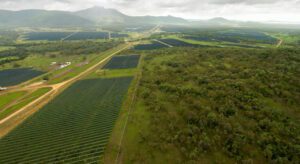Can just one day make or break an energy source? According to several media reports, including from both The Australian and the Australian Financial Review; 15 January 2014 was the day renewable energy failed Australia.
However, analysis of the National Electricity Market may suggest that its woes are in fact indicative of a volatile electricity market that would exist without renewable energy.
Last week saw one of the most intense heatwaves to hit the Southern states of Australia over the last few years. Notably, this heatwave was experienced, with almost equal intensity, simultaneously in Victoria and South Australia.
As one would expect, in the midst of a heatwave, people seek out a means of relief from the heat. The ubiquitous solution used in Australia is the loyal air conditioner.
In a case of unfortunate timing, as the nation sweltered last Wednesday, the heatwave in South Australia and Victoria coincided with a period of low wind in the those states. Wind turbines met just 11 per cent of the South Australia’s power demand on that day, while it will often deliver around triple that on better days.
In Victoria, wind dipped to just 1.4 per cent of demand, while regularly providing more than 5 per cent on a good day.
Was this unusual? Not at all. Wind is a variable supply of energy. Even the most ardent supporter of renewable energy doesn’t deny this. The National Electricity Market can accommodate such fluctuations through good planning and considered design.
Putting the fact that brown coal behemoth Loy Yang had a quarter of it’s capacity go offline in the midst of the heatwave peak aside (because, of course, the supply of base load generation from coal is apparently infallible), one must ask what impact did the reduced availability of wind really have?
With what some members of the press asserted, one would expect that fossil fuels would sweep in as the electricity sector’s White Knight, with its “stable and reliable” supply to keep our air conditioners blowing and beer fridges cold.
However, a stable market is far from what was observed. With fossil fuel generators left on their own to satisfy our energy demands on Wednesday, the average daily price in South Australia surged to $555, a vast increase compared to the 2013 daily average of just $69.06.
Intraday volatility in electricity prices was also significantly worse. Those who observed the market closely would have observed, during the hottest part of the day, prices in South Australia and Victoria bouncing between the NEM price ceiling ($13,100/MWh) and floor (-$1000/MWh) with regularity.
In the following two days, the 16th and 17th, the wind returned. With the heat remaining as high as it had in the days prior, price spikes continued to occur. However, with wind farms providing additional supply, these spikes were less extreme and occurred far less frequently.
The average NEM price on those days following also fell from its windless peak. NEM prices in both South Australia and Victoria fell by a factor of four between the 15th and 17th; Price volatility fell by a comparable factor, yet temperatures were just as high.
So, what can we take away from the performance of the NEM last week?
When we become completely reliant on fossil fuel generators, we experience higher wholesale electricity prices.
When we become completely reliant on fossil fuel generators, we experience significantly higher levels of volatility in the electricity market.
Wind, despite its variable nature, seemingly has a calming effect on the market. It’s supply keeps the market in check, prices low and predictable
To add to this effective defence of renewable energy in our electricity mix, it is possible to point out that the spike in Victorian demand was also partially met by imported hydro generation from Tasmania, with the Basslink interconnector between the two states running at capacity during the heatwave.
Likewise, it is obvious to point out in times of heatwaves; the potential for solar PV and solar thermal technologies to directly meet increased electricity demand is high. Wind, solar and hydro generators are all a perfect complement to each other, and we are already reliant on them to keep wholesale electricity prices low and stable.
More investment and support in their deployment is likely to provide further benefits to consumers, and electricity market participants alike.
It is important to remember the National Electricity Market is a complex beast. With network constraints and interconnector capacities adding another level of complexity to the task of balancing demand with supply, it’s too simplistic to point to what occurred in one state on one given day, and then make an assessment about the performance of a particular technology.
Especially when it’s possible to build such a compelling counter-argument using the same data.
South Australia:
Victoria:












